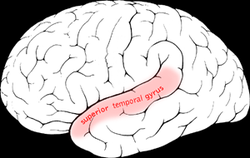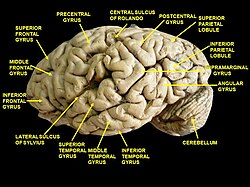| Superior temporal gyrus | |
|---|---|
 Superior temporal gyrus of the human brain. | |
 Cerebrum. Lateral view. Deep dissection. Superior temporal gyrus is visible at the center. | |
| Details | |
| Part of | Temporal lobe |
| Location | Temporal lobe of the human brain |
| Artery | Middle cerebral |
| Identifiers | |
| Latin | gyrus temporalis superior |
| NeuroNames | 136 |
| NeuroLex ID | birnlex_1648 |
| TA98 | A14.1.09.138 |
| TA2 | 5489 |
| FMA | 61905 |
| Anatomical terms of neuroanatomy | |
The superior temporal gyrus (STG[1]) is one of three (sometimes two) gyri in the temporal lobe of the human brain, which is located laterally to the head, situated somewhat above the external ear.
The superior temporal gyrus is bounded by:
- the lateral sulcus above;
- the superior temporal sulcus (not always present or visible) below;
- an imaginary line drawn from the preoccipital notch to the lateral sulcus posteriorly.
The superior temporal gyrus contains several important structures of the brain, including:
- Brodmann areas 41 and 42, marking the location of the auditory cortex, the cortical region responsible for the sensation of sound;
- Wernicke's area, Brodmann area 22, an important region for the processing of speech so that it can be understood as language.
The superior temporal gyrus contains the auditory cortex, which is responsible for processing sounds. Specific sound frequencies map precisely onto the auditory cortex. This auditory (or tonotopic) map is similar to the homunculus map of the primary motor cortex. Some areas of the superior temporal gyrus are specialized for processing combinations of frequencies, and other areas are specialized for processing changes in amplitude or frequency. The superior temporal gyrus also includes Wernicke's area, which (in most people) is located in the left hemisphere. It is the major area involved in the comprehension of language. The superior temporal gyrus is involved in auditory processing, including language, but also has been implicated as a critical structure in social cognition.[2][3]
Various parts of the STG might be referred to as anterior (aSTG), middle (mSTG), and posterior (pSTG).
- ^ Vander Ghinst, Marc; Bourguignon, Mathieu; Op de Beeck, Marc; Wens, Vincent; Marty, Brice; Hassid, Sergio; Choufani, Georges; Jousmäki, Veikko; Hari, Riitta; Van Bogaert, Patrick; Goldman, Serge; De Tiège, Xavier (2016). "Left Superior Temporal Gyrus Is Coupled to Attended Speech in a Cocktail-Party Auditory Scene". The Journal of Neuroscience. 36 (5): 1596–1606. doi:10.1523/JNEUROSCI.1730-15.2016. ISSN 0270-6474. PMC 6601992. PMID 26843641.Typical paper using the initials "STG".
- ^ Bigler, Erin D.; Mortensen, Sherstin; Neeley, E. Shannon; Ozonoff, Sally; Krasny, Lori; Johnson, Michael; Lu, Jeffrey; Provencal, Sherri L.; McMahon, William; Lainhart, Janet E. (2007). "Superior temporal gyrus, language function, and autism". Developmental Neuropsychology. 31 (2): 217–238. doi:10.1080/87565640701190841. ISSN 8756-5641. PMID 17488217.
- ^ Jou, RJ.; Minshew, NJ.; Keshavan, MS.; Vitale, MP.; Hardan, AY. (Nov 2010). "Enlarged right superior temporal gyrus in children and adolescents with autism". Brain Res. 1360: 205–12. doi:10.1016/j.brainres.2010.09.005. PMC 2990401. PMID 20833154.